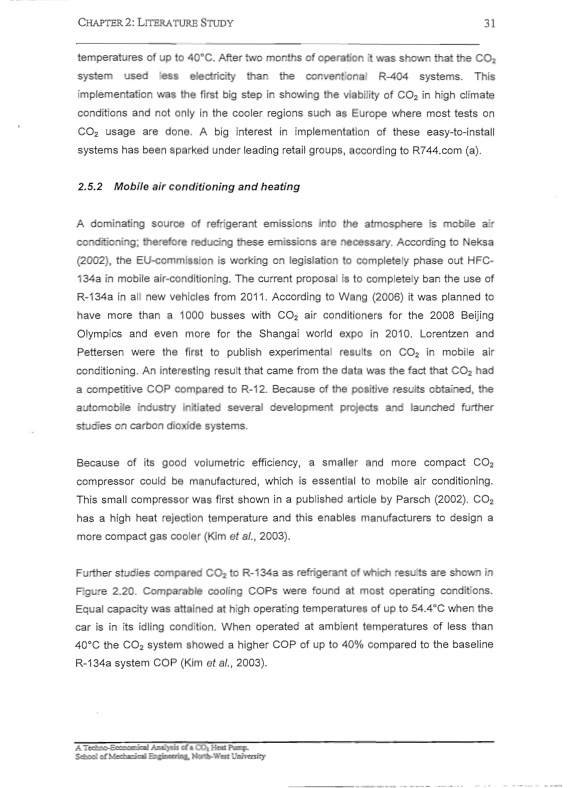
PDF Publication Title:
Text from PDF Page: 043
CHAPTER 2: LITERATURE STUDY 31 temperatures of up to 40°C. After two months of operation it was shown that the CO2 system used electricity than the conventional R-404 systems. This implementation was the first big step in showing the viability of CO2 in high climate conditions and not only in the cooler regions such as Europe where most tests on CO2 usage are done. A big interest in implementation of these easy-to-install systems has been sparked under leading retail groups, according to R744.com (a). 2.5,2 Mobile air conditioning and heating A dominating source of refrigerant emissions into the atmosphere is mobile air conditioning; therefore reducing these emissions are necessary. According to Neksa (2002), the EU-commission is working on legislation to completely phase out HFC 134a in mobile air-conditioning. The current proposal is to completely ban the use of R-134a in all new vehicles from 2011. According to Wang (2006) it was planned to have more than a 1000 busses with CO2 air conditioners for the 2008 Beijing Olympics and even more for the Shangai world expo in 2010. Lorentzen and Pettersen were the first to publish experimental results on CO2 in mobile air conditioning. An interesting result that came from the data was the fact that CO2 had a competitive COP compared to R-12. Because of the positive results obtained, the automobile industry initiated several development projects and launched further studies on carbon dioxide systems. Because of its good volumetric efficiency, a smaller and more compact CO2 compressor could be manufactured, which is essential to mobile air conditioning. This small compressor was first shown in a published article by Parsch (2002). CO2 has a high heat rejection temperature and this enables manufacturers to design a more compact gas cooler (Kim et al., 2003). Further studies compared CO2 to R-134a as refrigerant of which results are shown in Figure 2.20. Comparable cooling COPs were found at most operating conditions. Equal capacity was attained at high operating temperatures of up to 54.4°C when the car is in its idling condition. When operated at ambient temperatures of less than 40°C the CO2 system showed a higher COP of up to 40% compared to the baseline R-134a system COP (Kim et al., 2003). A Techno-Economical Analysis of a COl Heat Pump. School ofMechanicalEngineering, North-West UniversityPDF Image | CO2 HEAT PUMP Analysis

PDF Search Title:
CO2 HEAT PUMP AnalysisOriginal File Name Searched:
co2-heat-pump-techno-analysis.pdfDIY PDF Search: Google It | Yahoo | Bing
CO2 Organic Rankine Cycle Experimenter Platform The supercritical CO2 phase change system is both a heat pump and organic rankine cycle which can be used for those purposes and as a supercritical extractor for advanced subcritical and supercritical extraction technology. Uses include producing nanoparticles, precious metal CO2 extraction, lithium battery recycling, and other applications... More Info
Heat Pumps CO2 ORC Heat Pump System Platform More Info
| CONTACT TEL: 608-238-6001 Email: greg@infinityturbine.com | RSS | AMP |